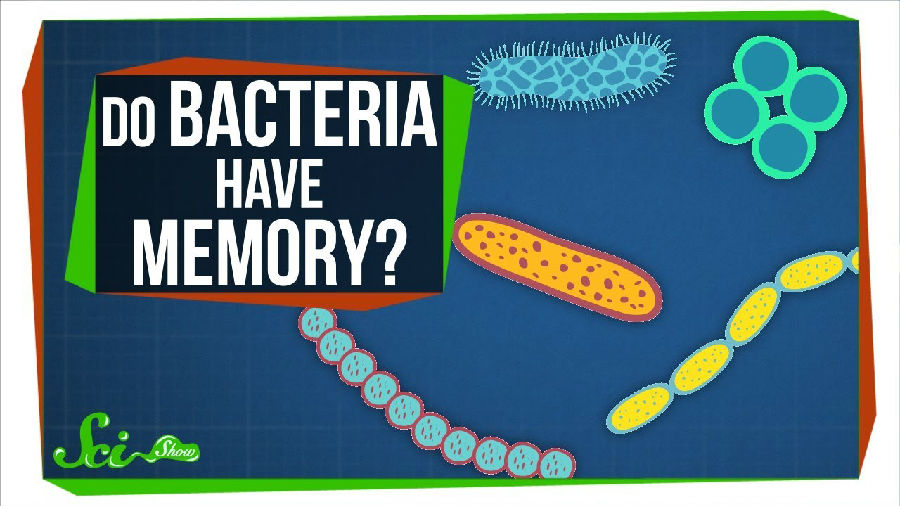Bacteria are teeny tiny organisms that play a huge role in our world.
微小的微生物细菌在人类的世界中扮演着重要角色。
And despite not having brains, they have pretty complex behaviors.
虽然它们没脑子,却有着相当复杂的行为。
These microbes can communicate by producing chemicals that spread to their neighbors,
这些细菌可以通过产生并传播化学物质来到达交流的目的
or cooperate by secreting digestive enzymes or virulence factors, which help them invade a host.
或是通过分泌消化酶或毒力因子相互合作帮助它们入侵宿主。
More surprisingly, bacteria even have a sort of memory.
更让人惊讶的是,细菌甚至有某种记忆力。
It's not the same as yours or mine you couldn't sit down with a bacterium and ask how its day was.
这种记忆不同于人类的记忆力,你也无法和细菌坐在一起问候它们今天过得怎么样。
But it does let these microbes alter future behaviors based on past events,
但是这种记忆能让这些细菌根据过去的经历调整未来的行为,
which can help them survive in changing environments. And that actually has important implications for our health, too.
从而帮助它们在不断变化的环境中生存。并且这对我们的健康也有这重要的暗示作用。
A lot of bacteria are harmless or even helpful for humans, but there are some that can be very dangerous.
很多细菌都是无害的或者甚至是对人类有帮助的,但是仍有一些细菌是非常危险的。
Especially the ones that are resistant to antibiotics, which are designed to kill them.
尤其是那些对抗生素有抵抗力的细菌。
Usually, we talk about antibiotic resistance developed by random mutations and evolution.
我们通常都说抗菌素耐药性都是随机突发或进化的。
Some bacteria will have genes that let them survive and reproduce in their environment even a stressful one filled with deadly chemicals.
一些细菌中含有某种基因,让它们在本身的环境中,甚至是在满是致命化学物质的环境,也能生存繁殖。
So those genes will be passed on to the next generation. That's evolution, where changes occur in a population over time.
因此那些基因将被已传至下一代。在这种进化中,这些变化会随着时间而发生于某个群体中。
But in the short term, a sort of memory may help bacteria survive an assault from antibiotics, too. Among other things.
但是从短期来看,一些记忆或许也能帮助细菌在抗生素的袭击中生存下来。
An individual bacterium might encounter something like a surface to live on,
个体细菌或许会遭遇类似表层之类的地方,并依靠化学
a chemical, or a new food source that causes biological changes within it.
或某种新的食物资源为生,这些资源会引起内部的化学变化。
Researchers have coined the term cellular memory to talk about this phenomenon,
研究人员创造了一种术语—细胞存储器,用于谈论这种现象,
in which the physical abilities of a cell depend on its past experiences.
在这种现象中,细胞的体能取决于它过去的经历。
In one 2017 study, scientists hit a group of bacteria with a high dose 2000 micrograms per milliliter of an antibiotic called ampicillin.
在2017年的一项研究中,科学家利用一种2000微克每毫升的高剂量抗生素氨苄青霉素检测一组细菌。
Ampicillin interferes with processes that bacteria use to build cell walls.
氨苄青霉素干扰细菌建立细胞壁的进程。
And without a strong cell wall, they can't survive very long.
没有了坚固的细胞壁,细菌无法长存。
If the bacteria had been exposed to a low dose of ampicillin before just 10 micrograms per milliliter
如果细菌暴露于小剂量氨苄青霉素中(10微克每毫升)
they were much more likely to survive than if they had never seen the antibiotic.
如果从未见过这种抗生素,这些细菌似乎活不了这么长时间。
In this experiment, the researchers weren't exactly sure what changes were making the cells tougher.
在这个试验中,研究人员并不确定是什么变化让细胞变得更加坚强。
But they do know that the type of bacteria they tested carries a set of genes that codes for a type of enzyme
但是他们确定他们所测试的这种种类的细菌携带有一组为某种酶提供指定代码的基因
that breaks down ampicillin and helps them survive.
这种酶可以分解氨苄青霉素,帮助细菌生存。
While these genes are always in the cell, they're not always turned on.
虽然这些基因总是存在于细胞中,但它们并不总是开启的。
So it's possible that these genes got turned on after the first tiny dose of ampicillin, making the bacteria more resistant to the second dose.
因此可能这些基因在注射第一组微量氨苄青霉素后就开启了,使得这些细菌对第二组剂量更有抵抗力。
Cellular memory also seems important in the formation of biofilms essentially a layer of slime and bacteria that coat a surface.
细胞存储器在生物膜形成中同样重要,本质上来讲,这种生物膜就是覆盖表面细菌表面的黏黏的那一层。
In the human body, harmful biofilms show up as plaque on teeth, as coatings on implants,
在人体中,有害生物膜是牙齿上的斑块,是埋植剂的涂层

and in the lungs of people who have cystic fibrosis or other chronic diseases.
也会出现在囊胞性纤维症或其他慢性疾病患者的肺部。
A 2018 study examined a species of bacteria called Pseudomonas aeruginosa.
一项2018年的研究对绿脓杆菌进行调查。
It's known for forming dangerous biofilms and can cause deadly lung infections.
绿脓杆菌可以形成危险的生物膜并引发致命肺部感染。
In this study, scientists found that bacteria that had never encountered any type of surface before weren't very good at attaching to one,
在这项研究中,科学家发现那些此前从未遭遇任何类型表面的细菌并不擅长于依附在表面上,
which is one of the first steps in forming a biofilm.
这是形成生物膜的初步步骤之一。
But bacteria that had previously attached to a surface were much better at grabbing on a second time.
但是此前依附过一个表面的细菌在第二次时更擅长于抓住表面。
The researchers attribute this to changes in the activity of the bacteria's pili small, hair-like structures that help them move around or stick to surfaces.
研究人员将这个归功于细菌菌毛活动的变化,这种小小的毛发似的结构帮助它们移动或是黏住表面。
In this study, when the bacteria "remembered" a surface, the pili moved a lot less.
在该研究中,当细菌“记得”某个表面时,菌毛就很少会移动。
So the bacteria were more likely to stay put instead of falling off.
因此细菌更有可能停留在原地而非掉落。
Not only that, but the bacteria that attached to a surface were able to pass these pili changes on to their descendants.
不仅如此,依附在表面的细菌还能够将这些菌毛变化遗传给它们的后代。
It's not entirely clear how, though, and we need to research this kind of cellular memory more.
我们并不清楚其原因,我们需要对这种细胞存储器进行更多研究。
Especially because blocking it might help us fight off dangerous bacteria.
尤其是因为阻碍这些遗传可以帮助我们对抗危险的细菌。
But there are other cases where we might be able to use bacterial memory to our advantage.
但是在一些其他情况下,这种细胞存储器也可以为我们所用。
For example, in a 2014 study, scientists engineered E. coli bacteria
例如,在一项2014年的研究中,科学家设计让大肠杆菌
to pass through the digestive system of a mouse and basically report on what they find.
穿过老鼠的消化系统,并报告它们的发现。
These detective bacteria were given two special genes.
这些侦查细菌被赋予了两种特殊的基因。
If one gene is turned on, the protein that it produces makes the second gene turn off, and vice versa.
如果其中一个基因被开启,其产生的蛋白质可以让第二个基因关闭,反之亦然。
So when the bacteria began their journey in the mouse gut, the first gene was on.
因此,当细菌在老鼠内脏中开始它们的旅途时,第一个基因是开启的。
But if the bacteria stumbled upon a certain chemical, called anhydrotetracycline, the second gene was activated instead.
但是如果细菌偶遇某种被称为无水四环素的化学物质,那么第二个基因就被会激活。
By measuring which genes were expressed when the bacteria got pooped out, scientists could tell whether that target chemical was around.
通过在细菌被排泄出来的时候,测量被表达的是哪种基因,科学家可以辨别目标化学物质是否在周围。
For this proof-of-principle study, they chose a chemical that isn't naturally occuring in mammals,
对于这个原理论证研究,他们选择了无法天然产生于哺乳动物体内的化学物质,
so they could just test whether their system worked. And it did!
这样他们就可以测试它们的系统是否有效。结果它们确实有效!
Because of this success, researchers hope to be able to engineer bacteria that can report on other chemicals that are linked with disease.
由于此次试验的成功,研究人员希望能够设计出一种细菌能够报道和疾病相关的其他化学物质。
So maybe someday, their cellular memory might help us diagnose inflammatory disorders, infections,
或许未来某天,它们的细胞存储器能够帮助我们诊断炎性疾病、感染
or even certain cancers all based on chemical markers. Not too shabby for little microbes.
甚至是某些基于化学性状的癌症。对小小的微生物来说,也不要那么苛刻。
Thanks for watching this episode of SciShow!
感谢收看本期科学秀!
If you want to learn more about the weird and sometimes awesome things bacteria can do,
如果你想了解更多关于细菌的诡异且惊奇的知识,
check out our list show with 6 bacterial superpowers! And don't forget to subscribe for a new video every day of the week.
点击观看我们视频观看细菌的6种超能力。不要忘记订阅我们的频道,每周收看最新视频。











